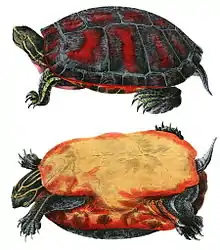Hispaniolan slider
The Hispaniolan slider (Trachemys decorata) or Haitian slider is a species of turtle in the family Emydidae found on the island of Hispaniola (Haiti and the Dominican Republic).[1]
| Hispaniolan slider | |
|---|---|
 | |
| Scientific classification | |
| Domain: | Eukaryota |
| Kingdom: | Animalia |
| Phylum: | Chordata |
| Class: | Reptilia |
| Order: | Testudines |
| Suborder: | Cryptodira |
| Superfamily: | Testudinoidea |
| Family: | Emydidae |
| Genus: | Trachemys |
| Species: | T. decorata |
| Binomial name | |
| Trachemys decorata (Barbour & Carr, 1940) | |
| Synonyms[2] | |
| |
Habitat
The Hispaniolan slider is a freshwater turtle. They can live on land and water, but prefer to be near freshwater.[3]
Conservation
These sliders are not on the endangered list, but are considered vulnerable.
Diet
They have a particular diet that consists of insects (crickets), fish, vegetation, etc. When kept in captivity, they can eat all of the same foods that they would eat normally, as well as turtle pellets, carrots, tomatoes, peeled grapes, and spinach.[4]
Appearance
Unlike red-eared sliders, they do not have red patches on their heads. They have distinct light and dark stripes on their necks, feet, and tails. The tops of their shells are brown and the bottoms are yellow.[5]
References
- Tortoise & Freshwater Turtle Specialist Group (2016) [errata version of 1996 assessment]. "Trachemys decorata". IUCN Red List of Threatened Species. 1996: e.T22019A97299007. doi:10.2305/IUCN.UK.1996.RLTS.T22019A9346521.en. Retrieved 26 June 2022.
- Fritz Uwe; Peter Havaš (2007). "Checklist of Chelonians of the World" (PDF). Vertebrate Zoology. 57 (2): 202. Archived from the original (PDF) on 1 May 2011. Retrieved 29 May 2012.
- "Welcome to ATP".
- "Feeding Red Eared Sliders and Other Aquatic Turtles - How to Feed.", Choosing an Exotic Pet - Care of Exotic Pets. Web. 5 March (2010)
- "World Chelonian Trust - Trachemys Gallery".
- "World Chelonian Trust - Trachemys Gallery.", World Chelonian Trust - Turtle and Tortoise Conservation and Care. Web. 5 March (2010).

